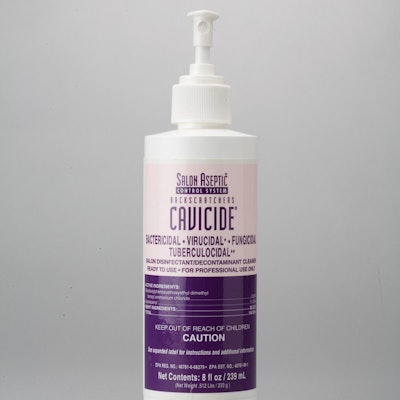
“When it comes to cleaning and disinfection, we don’t want to do OK,” says Doug Schoon, chief scientific advisor for CND. “We don’t want to do good. We want to follow instructions exactly. If the manufacturer’s instructions are not followed exactly, you can’t expect that it was properly disinfected.”
One of the biggest issues, according to Schoon, is that some nail techs make up their own cleaning and disinfection routines rather than following manufacturer or state board instructions. “Most people don’t do enough if they make up their own procedures,” says Schoon. For example, if your disinfectant’s formulation is too weak or too strong, it won’t be effective, since the effectiveness is guaranteed at only certain strengths. Leaving the solution in the basin for too long or short of a time can also be harmful. “Too short of a time might not kill all the organisms. Too long of a time, you can start to corrode the insides of your tub and create little microscopic pits where the bacteria can begin to grow faster.”
Wherever you create conditions that are conducive for bacteria to grow, they’ll grow. “Same with plants,” says Schoon. “If the conditions are right and the plant has plenty of fertilizer, a place to grow where it’s happy, warmth and moisture, it will grow. [Bacteria] also needs those four things to at least survive and then, if conditions are right, they begin to multiply.”
Here’s what you should know about the disinfectants and detergent cleaner’s you’re using:
A. EPA registered liquid disinfectants used in the salon:
i. must have the words ‘bactericidal, fungicidal and virucidal’ and ‘hospital’ on the label.
ii. must be mixed, used, stored and disposed of according to manufacturer’s label instructions.
*It is against Federal Law to use an EPA registered disinfectant contrary to its label.
iii. must be prepared fresh every day and replaced immediately when the solution becomes visibly contaminated.
iv. are ineffective when proper cleaning is not performed before use.
v. requires complete immersion in the correct amount of disinfectant for 10 minutes after cleaning of all visible residue. Complete immersion means enough liquid to cover all surfaces of the item. Note: If the disinfectant manufacturer’s label requires a different immersion time for soaking, you should always follow the label’s instructions.
vi. Spray disinfectants are for cleaning surfaces only and are not adequate for disinfecting tools and pedicure equipment in the salon.
B. EPA registered hospital “one-step” cleaner/disinfectants may be used for disinfecting pedicure equipment if:
i. they are EPA registered, hospital, bactericidal, fungicidal and virucidal and have the words ‘one-step’ on the label.
ii. tools and equipment are first cleaned of large amounts of residue.
iii. are used exactly as described by the manufacturer’s instructions.
C. All bottles and containers (other than the original manufacturers’ container) containing any disinfectant must be properly labeled listing the contents, percentage solution (concentration) and date of mixing.
D. Surfactant chelating detergents break down residue from pedicure products and are effective in hard water. Hard water contains calcium and magnesium ions, which can inactivate disinfectants and create residue films that are difficult for ordinary detergents to remove.
E. All brushes used to remove visible debris from the footspa, tub or basin must be properly cleaned and disinfected between each use.
F. You must record the time of each cleaning procedure in the salon pedicure cleaning log. Keep a log available to show clients. It demonstrates that you regularly clean and disinfect your pedicure equipment to ensure that the customer is protected.
G. Read and follow the instructions provided with the pedicure equipment to ensure proper use.
Source: International Nail Technicians Association
– Ilona French
Image:











